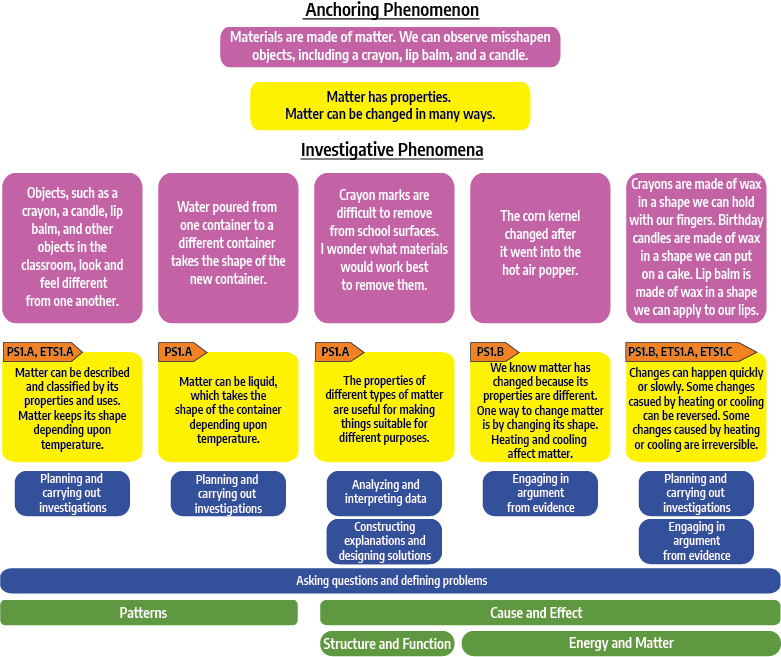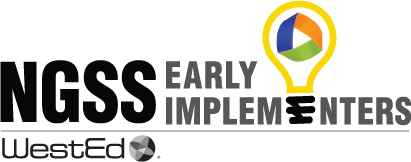
The anchoring phenomenon for this unit is: Materials are made of matter. We can observe misshapen objects, including a crayon, lip balm, and a candle. In this unit, students explore, observe patterns, describe, and sort properties of solid and liquid matter by planning and carrying out investigations. Students collect and analyze data to determine that different properties of different materials suit them for different purposes. Students investigate phenomena illustrating reversible and irreversible changes caused by heating or cooling to write claims based upon observable evidence regarding the cause and effect of these changes. Students apply their understanding of changes made to matter by developing a plan that uses a design process. The design process ultimately leads students to understand what can cause a change in the shape of matter. Students also begin to use an engineering design process to solve a problem related to the anchoring phenomenon.
The Performance Expectations (PEs) addressed in this unit are:
| 2-PS1-1 | Plan and conduct an investigation to describe and classify different kinds of materials by their observable properties. |
|---|---|
| 2-PS1-2 | Analyze data obtained from testing different materials to determine which materials have the properties that are best suited for an intended purpose. |
| 2-PS1-4 | Construct an argument with evidence that some changes caused by heating or cooling can be reversed and some cannot. |

The Learning Sequence Narrative briefly describes what students do in each lesson and helps to establish links between the lessons as a conceptual storyline. At the end of each lesson, students make connections to their understanding of the investigative phenomenon (and to the anchoring phenomenon, if appropriate). The investigative phenomenon for the lessons are: objects, such as a crayon, candle, lip balm, and objects in the classroom, look and feel different from one another (Lesson 1: Properties of Matter); water poured from one container to a different container takes the shape of the new container (Lesson 2: Properties of Liquids); crayon marks are difficult to remove from school surfaces. I wonder what materials would work best to remove them (Lesson 3: Different Properties for Different Purposes); corn kernels changed after they went into the hot air popper (Lesson 4: Reversible and Irreversible Changes); and crayons are made of wax in a shape we can hold with our fingers; birthday candles are made of wax in a shape that we can put on a cake; lip balm is made of wax in a shape that we can apply to our lips (Lesson 5: The Great Wax Disaster).
Students figure out this phenomenon by:
Planning and Carrying Out Investigations
Analyzing and Interpreting Data
Constructing Explanations and Designing Solutions
Engaging in Argument from Evidence
Asking Questions and Defining Problems
Obtaining, Evaluating, and Communicating Information
PS1.A: Structure and Properties of Matter
PS1.B: Chemical Reactions
ETS1.A: Defining and Delimiting Engineering Problems
ETS1.C: Optimizing the Design Solution
Patterns
Cause and Effect
Structure and Function
Energy and Matter
The following Learning Sequence Narrative is based on the conceptual flow concept map above.
Investigative Phenomenon: Objects, such as a crayon, a candle, lip balm, and other objects in the classroom, look and feel different from one another.
This lesson primarily serves as an introduction to properties of matter, with the focus on building an understanding the properties of solids. As students engage in observations of solid matter around them, they have opportunities to connect their language to the corresponding scientific vocabulary. Lesson 1: Properties of Matter introduces students to the anchoring phenomenon: Materials are made of matter; We can observe misshapen objects, including a crayon, lip balm, and a candle. Students are introduced to the development of an engineering problem by posing questions such as: How did the objects get this way? How can we keep this from happening to the objects? Students use their prior knowledge of daily interactions with matter as they begin thinking about the everyday objects around them and the properties of the materials from which they are made. Students use prior knowledge of the five senses to make observations and find patterns in their observations to sort solid materials and classify them by their properties. In Lesson 2: Properties of Liquids, students investigate the properties of liquids.
Investigative Phenomenon: Water poured from one container to a different container takes the shape of the new container.
In Lesson 1: Properties of Matter, students observed, described, and classified the properties of solid materials. Students also began to develop an engineering problem. In this lesson, students plan and conduct investigations to observe and classify patterns of properties of liquids to answer a question generated by the class. Students use their observations to compare the properties of liquids and solids. The properties of liquids relate to the observable part of the anchoring phenomenon (misshapen objects, including a crayon, lip balm, and a candle) because eventually students are going to understand that when some solids melt, they spread out to take the shape of their container and later return to a solid state, e.g., chocolate bars, chocolate bunnies, etc. This foundational understanding of the properties of matter will help students with the Plan phase of the Engineering Design Process. In Lesson 3: Different Properties for Different Purposes, students explore the idea that materials are used for different purposes depending on their properties.
Investigative Phenomenon: Crayon marks are difficult to remove from school surfaces. I wonder what materials would work best to remove them.
This lesson builds on ideas developed in the two prior lessons in which students planned and conducted investigations to explore patterns in the properties of solid and liquid materials. In this lesson, students are presented with a problem and record data as they test the use of materials with different properties to solve the problem. Students collect and analyze more data to determine the materials that can be used to solve the problem and to explain the properties of the materials that made them suited for the solution. Students use what they have learned in this lesson to add to their engineering design plan. In Lesson 4: Reversible and Irreversible Changes, students learn to make a claim based on evidence they gain from exploring the reversible and irreversible changes caused by heating or cooling matter.
Investigative Phenomenon: The corn kernel changed after it went into the hot air popper.
In Lesson 3: Different Properties for Different Purposes, students investigated the use of materials for different purposes depending upon their properties. In this lesson, students learn to construct a claim based on evidence they observe from exploring the reversible and irreversible changes that are caused by heating or cooling different substances. In Lesson 5: The Great Wax Disaster, students build on their new understandings as they return to the anchoring phenomenon of observing misshapen objects in order to develop a plan to change the shape of a piece of chocolate.
Investigative Phenomenon: Crayons are made of wax in a shape we can hold with our fingers. Birthday candles are made of wax in a shape that we can put on a cake. Lip balm is made of wax in a shape that we can apply to our lips.
In Lesson 4: Reversible and Irreversible Changes, students constructed a claim based on evidence as they explored the reversible and irreversible changes that are caused by heating or cooling different substances. In this final lesson, students return to the observable part of the anchoring phenomenon in order to develop a plan to support their understanding from Lesson 4: Reversible and Irreversible Changes that the changes that occurred to the misshapen objects are reversible or irreversible. Students use a design process and the Engineering Planning Sheet to develop a plan, compare plans with others, and collaboratively revise their plans. After conducting the investigation, students use their data to write a claim of how and if solid objects can be turned into a different shape. From their experiences with properties of materials and whether properties of materials are affected by heating and cooling, the students are now able to explain the phenomena of the misshapen objects.
Only SEPs that have a strong progression are detailed here. While other SEPs are included in the sequence and important to the lesson in which they are used, they are not outlined here if they do not appear in multiple lessons.
The Grade 2: Matter unit provides multiple and ongoing strategies for teachers to assess student understanding as they progress toward mastery of Performance Expectations. These include:
 ) denotes formative assessment opportunities where you may change instruction in response to students’ level of understanding and emergent sense-making of phenomena.
) denotes formative assessment opportunities where you may change instruction in response to students’ level of understanding and emergent sense-making of phenomena.View the Voice to Text video (https://www.youtube.com/watch?v=Hq6eLFnwzsI) which would allow a student to speak their answer and have it converted to text.
Student Instructions:
Students can create a digital science notebook that can be a combination of images and student recordings. Students can record themselves sharing what they observed/saw, thought/wondered, and learned during or after an experience.
This support can assist English Learners or students with reading difficulties by allowing time to activate prior knowledge and discuss new vocabulary.
Monica Aguirre, Resource Teacher/TOSA, Vista Unified School District
Katherine Altmann, 2nd Grade Teacher, San Diego Unified School District
Deborah Gordon, Science/STEM TOSA, Palm Springs Unified School District
Jo Topps, Regional Director, WestEd/K–12 Alliance
Barbara Woods, NGSS Project Director, Galt Joint Union Elementary School District
Kathy Jones, Chico Unified School District
Dana Nielson, San Diego Unified School District
Kathy Jones, Chico Unified School District
Dana Nielson, San Diego Unified School District
Achieve Science Peer Review Panel

A Collaboration of the K-12 Alliance @ WestEd, Aspire Public Schools, Galt JUSD, High Tech High, Kings Canyon USD, Lakeside USD, Oakland USD, Palm Springs USD, San Diego USD, Tracy USD, Vista USD, Achieve, and the California Department of Education
with funding from the S.D. Bechtel, Jr. Foundation and Hastings-Quillin Fund
The California K–8 NGSS Early Implementation Initiative, developed by the K–12 Alliance at WestEd with close collaborative input on its design and objectives from the State Board of Education, the California Department of Education, and Achieve is a fast-start demonstration project to build local education agency (LEA) capacity to fully implement the Next Generation Science Standards (NGSS) as a core subject in the elementary grades (K–5) and as the SBE’s preferred integrated model in grades 6–8.
The four-year Initiative provides teachers and administrators with in-depth, content-rich professional development to build leadership capacity and teacher acumen to deliver high-quality 3-dimensional learning for K–8 students. In addition, through collaborations among the K–12 Alliance, Achieve, and others, the LEAs in the Collaborative have opportunities to pilot test new NGSS-aligned tools, processes, assessment item prototypes, and digital and other instructional materials. The LEAs serve as resources for NGSS implementation across California, and in other NGSS-adopting states as well.
Participants in the CA NGSS K–8 Early Implementation Initiative developed and field-tested the lessons in the learning sequence. The sequences were vetted by Science Peer Review Panel using Achieve’s EQuiP rubric for science and found to be aligned with the intent of the NGSS.
Community Resources for Science (CRS). “Science Talks” Accessed October 22, 2019. http://www.crscience.org/pdf/Science.Talk.Structures.pdf
NGSS Lead States. 2013. Next Generation Science Standards: For States, By States. Washington, DC: The National Academies Press.